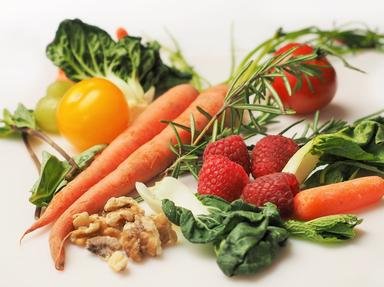Quiz Answer Key and Fun Facts
1. B - Which of these fruits grows on a leafy tropical plant that looks as though it could be mistaken for a palm tree?
2. C - Which of these fruits is very popular for use in a sauce at Thanksgiving in the United States and at Christmas in the UK?
3. D - Which of these fruits is used as a staple food in the desert regions of North Africa and the Middle East?
4. E - Which of these fruits, popular as a flavouring in pancakes and muffins, needs to be cooked to destroy a poisonous alkaloid that naturally occurs in it?
5. F - Which fruit, of a tropical and subtropical tree, has two or three types which require a small wasp to achieve fertilisation and reproduction?
6. G - Which popular fruit, grown on vines, is used for making wine, raisins, currants and sultanas?
7. H - To most people, which one of these options might not be seen as a fruit but, in spite of its hard exterior, is botanically classified as a fruit?
8. I - Which fruit, native to South America, has long pods inside which are black seeds embedded in a white pulp?
9. J - Which tropical fruit is the largest tree-borne fruit in the world, being known to reach 40 kg (or 90 lb) in weight?
10. K - Which fruit is a small variety of orange whose orange-coloured rind is edible, so that it is often eaten whole?
11. L - Which of these is a dark red hybrid fruit named after the American horticulturist who accidentally created it?
12. M - Which juicy fruit comes in different categories with names such as Cantaloupe and Honeydew?
13. N - Which fruit is a variety of peach and is named after the mythical life-giving drink of the ancient gods?
14. O - The juice of which citrus fruit is used in making the cocktail called Bucks Fizz?
15. P - Which of these fruits grows on a short stem from a plant with sharp leaves?
16. Q - Which of these fruits is a relative of apples and pears, but with more varieties that need to be cooked (for taste, not because of health risks) before eating?
17. R - Which exotic fruit, native to Malaysia, is similar to lychee and has long hairs on the outside?
18. S - Which of these fruits is a type of plum, with a Spanish-sounding name, which comes from a tree native to Mexico and Central America?
19. T - Which fruit, native to South America, is classified as a vegetable in cooking?
20. U - Which of these is a citrus fruit, originally from Jamaica, and is a hybrid of grapefruit, orange and tangerine?
21. V - Which of these fruits, also known as African tamarind, or common wild medlar, has a smooth yellow-brown appearance when ripe, and a pulp with a chocolate-like flavour?
22. W - Which of these is the Australian name for a tree, native to northern Queensland and south-east Asia, with a beige-coloured fruit which is also known, confusingly, as caqui?
23. X - It's difficult to find a fruit whose name begins with the letter X, so which of these is the only fruit? Hint: it is the Chinese name for watermelon.
24. Y - You might have heard of Damson jam, but which of these fruits would you use to make Mirabelle jam?
25. Z - Which fruit (again mistaken for a vegetable because of its culinary uses) is also known as courgette?
Source: Author
Kenners158
This quiz was reviewed by FunTrivia editor
WesleyCrusher before going online.
Any errors found in FunTrivia content are routinely corrected through our feedback system.

